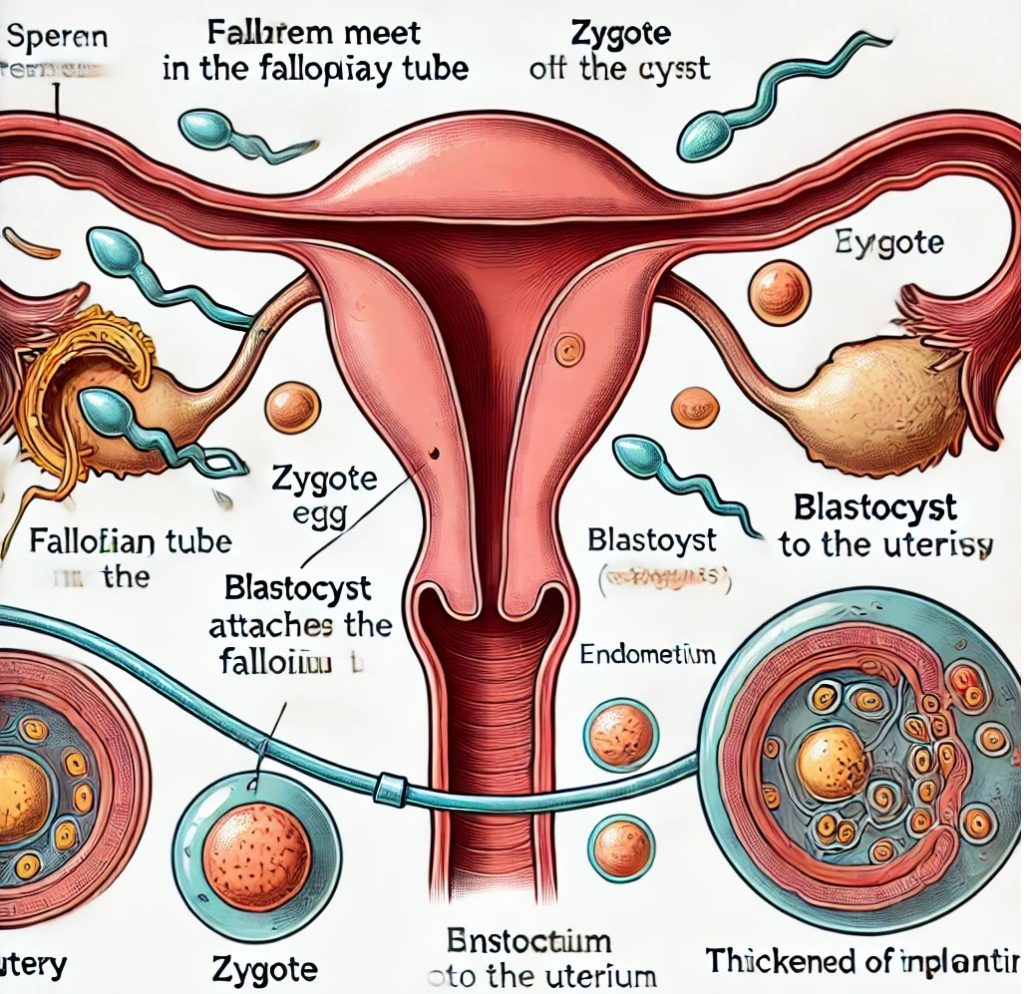
Fertilization and implantation are two key stages in human reproduction that lead to pregnancy. Fertilization is the union of the sperm and egg, while implantation is when the fertilized egg attaches itself to the lining of the uterus. These processes involve intricate biological changes and interactions, orchestrated by hormones and cellular signals. Let’s go through these concepts in detail.
1. Fertilization: The Union of Sperm and Egg
Fertilization occurs when a sperm cell from the male fuses with an egg (ovum) released from the female’s ovary during ovulation. This process typically happens in the fallopian tube, the passage between the ovary and uterus.
Steps of Fertilization
- Sperm Transport: After ejaculation, millions of sperm are released into the female reproductive tract. Only a few hundred survive the journey through the cervix and uterus to reach the fallopian tube.
- Sperm-Egg Recognition: In the fallopian tube, the sperm encounters the egg. The egg is surrounded by a protective layer called the zona pellucida. The sperm must penetrate this layer to fertilize the egg. Enzymes released from the sperm’s head (acrosome) break down this outer layer.
- Fusion of Sperm and Egg: Once a sperm successfully penetrates the zona pellucida, the membranes of the sperm and egg fuse, allowing the sperm to enter the egg.
- Cortical Reaction: After the sperm enters, the egg undergoes a reaction that prevents other sperm from entering. This ensures only one sperm fertilizes the egg, leading to the formation of a zygote (fertilized egg).
- Combining Genetic Material: The sperm and egg each contribute half of the genetic material (23 chromosomes from each). Once fused, they create a complete set of 46 chromosomes, forming the zygote.
Importance of Fertilization
Fertilization is essential as it combines the genetic material from both parents, resulting in a unique organism with a complete set of chromosomes. The zygote begins to divide rapidly, forming a blastocyst, which will travel toward the uterus for the next stage—implantation.
Example of Fertilization
Imagine fertilization as two puzzle pieces coming together. The sperm and egg are each a piece with half the information needed to form a new puzzle (the baby). When they connect, they create a complete picture.
2. Implantation: Embedding in the Uterus
Implantation is the process where the fertilized egg (now a blastocyst) attaches itself to the lining of the uterus (endometrium). Implantation occurs about 6-10 days after fertilization.
Steps of Implantation
- Travel to the Uterus: After fertilization, the zygote divides and forms a blastocyst (a ball of cells). The blastocyst travels down the fallopian tube towards the uterus over a period of about 5-7 days.
- Blastocyst Development: By the time the blastocyst reaches the uterus, it has differentiated into two layers:
- Inner cell mass: This becomes the embryo.
- Trophoblast: This outer layer will form the placenta.
- Attachment to the Endometrium: The blastocyst reaches the uterus and starts to attach itself to the thickened uterine lining (endometrium), which has been preparing to nourish it.
- Invasion into the Endometrium: The trophoblast cells invade the endometrium, embedding the blastocyst firmly within the uterine wall. This process helps the developing embryo access nutrients and oxygen from the mother.
- Formation of the Placenta: The trophoblast forms the placenta, which is the organ that will provide nutrients and remove waste from the embryo throughout pregnancy.
- hCG Hormone Production: After implantation, the cells of the blastocyst produce human chorionic gonadotropin (hCG). This hormone signals to the body to maintain the uterine lining and prevent menstruation, supporting the developing embryo.
Importance of Implantation
Implantation is crucial because it allows the developing embryo to receive oxygen and nutrients from the mother. Without successful implantation, the pregnancy cannot progress. In some cases, failure to implant leads to early miscarriage or failed pregnancy.
Example of Implantation
Think of the uterus as a nutrient-rich garden bed and the fertilized egg as a seed. The seed (blastocyst) must embed itself into the soil (endometrium) to grow and thrive. Once planted, the seed will grow into a healthy plant, much like how the embryo develops into a baby.
Factors Affecting Fertilization and Implantation
Several factors can influence the success of fertilization and implantation:
- Timing: Fertilization can only occur if sperm meet the egg during or shortly after ovulation. Sperm can survive for up to 5 days inside the female body, but the egg is viable for only 12-24 hours after ovulation.
- Health of the Reproductive System: Healthy fallopian tubes are essential for transporting the egg and sperm. Any blockages or damage to the tubes can prevent fertilization or the passage of the zygote to the uterus.
- Hormonal Balance: The right balance of hormones (especially estrogen and progesterone) is essential for preparing the uterine lining and supporting implantation. Hormonal imbalances can interfere with the cycle.
- Quality of Egg and Sperm: The genetic quality and health of both the egg and sperm affect the chances of successful fertilization and implantation. Chromosomal abnormalities can lead to failure in these processes.
- Lifestyle Factors: Stress, smoking, excessive alcohol consumption, and poor diet can negatively impact both fertility and implantation success.
See in Fig:

The diagram shows how the sperm meets the egg in the fallopian tube, the formation of the zygote, and the journey of the blastocyst towards the uterus, where it implants into the thickened uterine lining. This step-by-step depiction helps illustrate how pregnancy begins.
Important Questions and Answers related to Fertilization and Implantation
1. What is fertilization?
- Answer: Fertilization is the process where a sperm cell from the male fuses with an egg cell (ovum) from the female, typically in the fallopian tube. This results in the formation of a zygote, which is the first stage of a developing embryo.
2. Where does fertilization take place in humans?
- Answer: Fertilization in humans typically occurs in the fallopian tube, which connects the ovary to the uterus.
3. What is the role of the zona pellucida in fertilization?
- Answer: The zona pellucida is the protective outer layer surrounding the egg. It ensures that only one sperm fertilizes the egg by blocking additional sperm from entering after the first one has successfully penetrated.
4. What happens to the sperm once it enters the egg?
- Answer: Once the sperm enters the egg, their genetic material (chromosomes) combines, forming a zygote with a complete set of 46 chromosomes. This marks the beginning of the embryo’s development.
5. What is a zygote?
- Answer: A zygote is the single-celled organism formed when the sperm and egg fuse during fertilization. It contains 46 chromosomes, with genetic material from both the mother and father.
6. What is implantation?
- Answer: Implantation is the process where the fertilized egg (now a blastocyst) attaches itself to the lining of the uterus (endometrium) about 6-10 days after fertilization. This is crucial for the development of the embryo and the continuation of pregnancy.
7. What is the role of the blastocyst in implantation?
- Answer: The blastocyst is the stage of the fertilized egg that implants into the uterine lining. It consists of an inner cell mass, which will become the embryo, and an outer layer (trophoblast) that will develop into the placenta.
8. What hormone is produced after implantation and why is it important?
- Answer: After implantation, the blastocyst produces human chorionic gonadotropin (hCG). This hormone maintains the uterine lining and prevents menstruation, which is essential for sustaining the pregnancy.
9. What happens if the fertilized egg does not implant properly?
- Answer: If the fertilized egg does not implant properly, the pregnancy cannot progress. The uterine lining will shed, resulting in menstruation, and the fertilized egg will be lost.
10. How long after fertilization does implantation occur?
- Answer: Implantation typically occurs 6-10 days after fertilization, once the blastocyst has reached the uterus and is ready to embed into the uterine lining.






